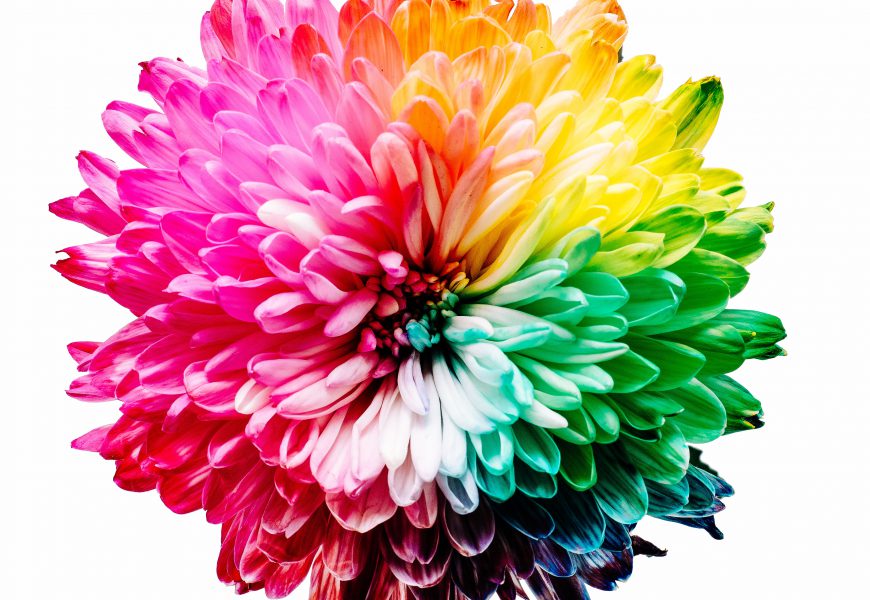In every country, colours have symbolic associations to their art, heritage and traditions. Let’s take the colour of mourning, for instance. In some parts of East Asia and Europe, the colour for mourning is white, while it is black in the Western world. And in some parts of South America and Thailand, the colour for mourning is purple and red in South Africa.
Colours signify different meanings in different places. In this article, let’s focus on the symbolism of colours in Japan, as traditional Japanese colours still play an essential role in Japanese Culture.
But, before we go into details, let’s learn how to say different colours in Japanese.
- Basic Colors in Japanese Language
- Different Shades Of Black In Japanese
- Different Shades Of Blue In Japanese
- Different Shades Of Red In Japanese
- Different Shades Of Green In Japanese
- Different Shades Of Brown In Japanese
- Different Shades Of Pink In Japanese
- Different Shades Of Purple In Japanese
- Different Shades Of White In Japanese
- Different Shades Of Yellow In Japanese
- Meaning of Colors in Japanese
Basic Colors in Japanese Language

- Red in Japanese – Aka (赤)
- Blue in Japanese – Ao (青)
- Green in Japanese – Midori (緑)
- Yellow in Japanese – Ki (黄)

- Pink in Japanese – Pinku (ピンク)
- Purple in Japanese – Murasakino (紫の)
- Orange in Japanese – Orenji (オレンジ)

- Black in Japanese – Kuro (黒)
- Brown in Japanese – Chairo (茶色)
- Grey in Japanese – Gurē (グレー)
- Gold in Japanese – Gōrudo (ゴールド)
- Silver in Japanese – Gin (銀)
- White in Japanese – Shiroi (白い)
Different Shades Of Black In Japanese
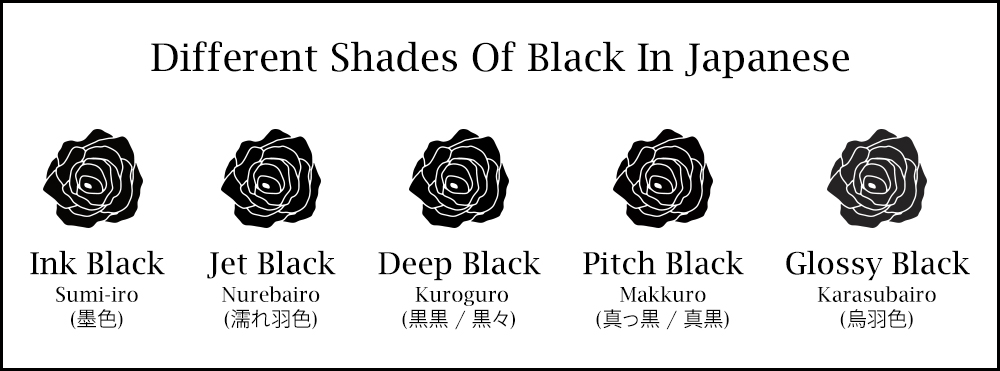
- Ink Black – Sumi-iro (墨色)
- Jet Black – Nurebairo (濡れ羽色)
- Deep Black – Kuroguro (黒黒 / 黒々)
- Pitch Black – Makkuro (真っ黒 / 真黒)
- Glossy Black – Karasubairo (烏羽色)
Different Shades Of Blue In Japanese
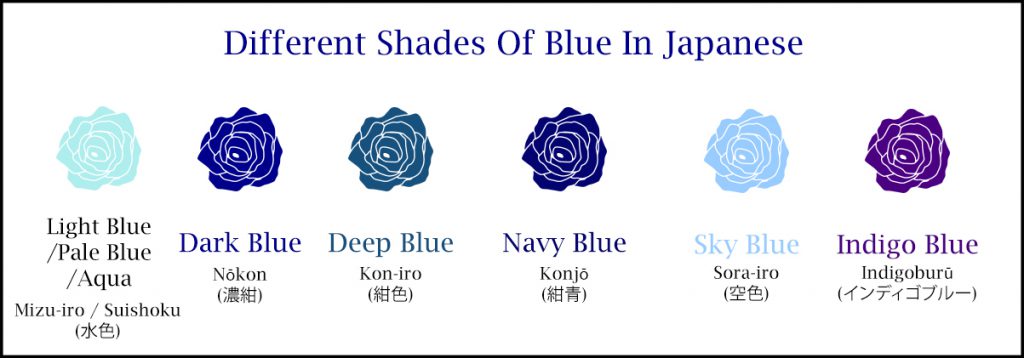
- Light Blue/Pale Blue/Aqua – Mizu-iro / Suishoku (水色)
- Dark Blue – Nōkon (濃紺)
- Deep Blue – Kon-iro (紺色)
- Navy Blue – Konjō (紺青)
- Sky Blue – Sora-iro (空色)
- Indigo Blue – Indigoburū (インディゴブルー)
Different Shades Of Red In Japanese
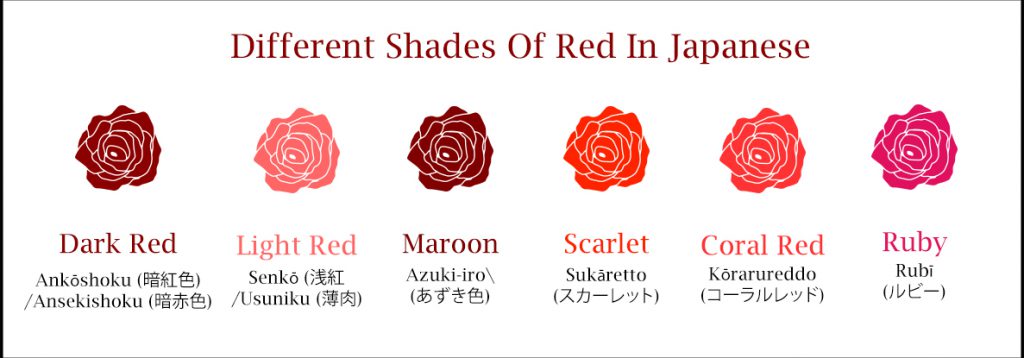
- Dark Red – Ankōshoku (暗紅色)/Ansekishoku (暗赤色)
- Light Red – Senkō (浅紅)/Usuniku (薄肉)
- Maroon – Azuki-iro (あずき色)
- Scarlet – Sukāretto (スカーレット)
- Coral Red – Kōrarureddo (コーラルレッド)
- Ruby – Rubī (ルビー)
Different Shades Of Green In Japanese
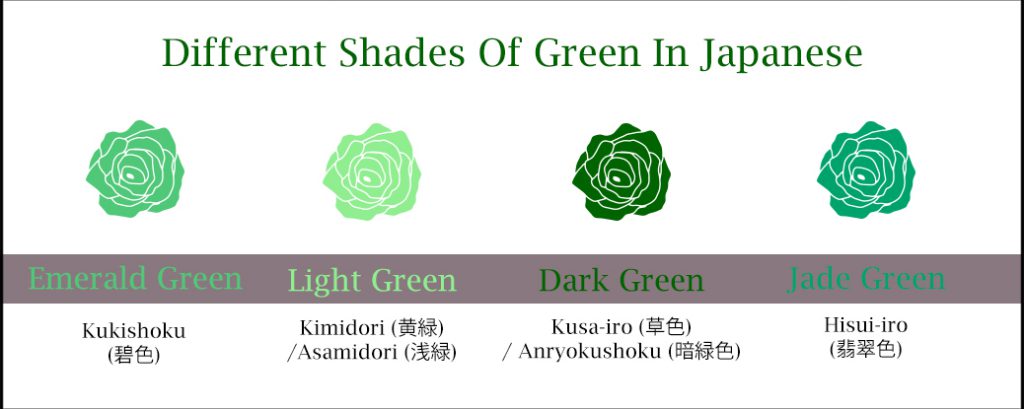
- Emerald Green – Kukishoku (碧色)
- Light Green – Kimidori (黄緑)/Asamidori (浅緑)
- Dark Green – Kusa-iro (草色)/ Anryokushoku (暗緑色)
- Jade Green – Hisui-iro (翡翠色)
Different Shades Of Brown In Japanese
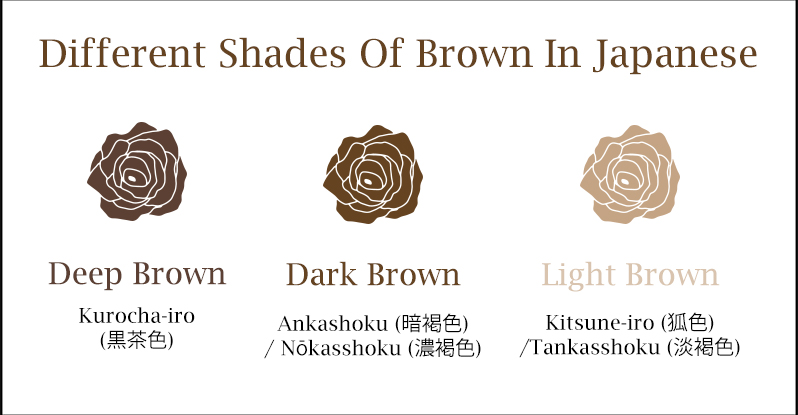
- Deep Brown- Kurocha-iro (黒茶色)
- Dark Brown – Ankashoku (暗褐色) / Nōkasshoku (濃褐色)
- Light Brown – Kitsune-iro (狐色)/Tankasshoku (淡褐色)
Different Shades Of Pink In Japanese
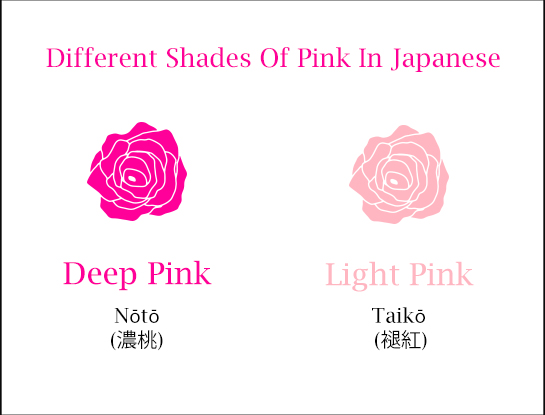
- Deep Pink – Nōtō (濃桃)
- Light Pink – Taikō (褪紅)
Different Shades Of Purple In Japanese
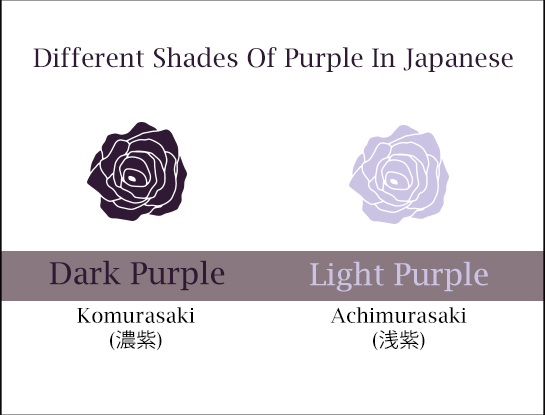
- Dark Purple – Komurasaki (濃紫)
- Light Purple – Achimurasaki (浅紫)
Different Shades Of White In Japanese
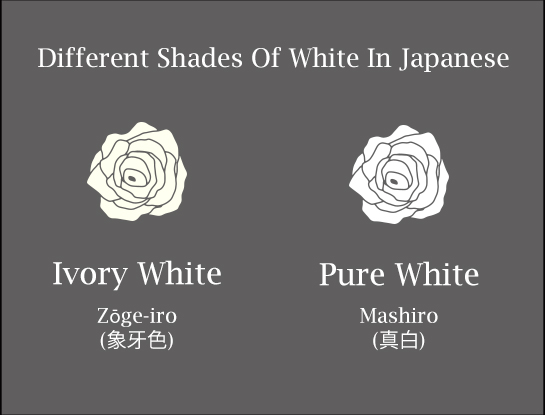
- Ivory White – Zōge-iro (象牙色)
- Pure White – Mashiro (真白)
Different Shades Of Yellow In Japanese
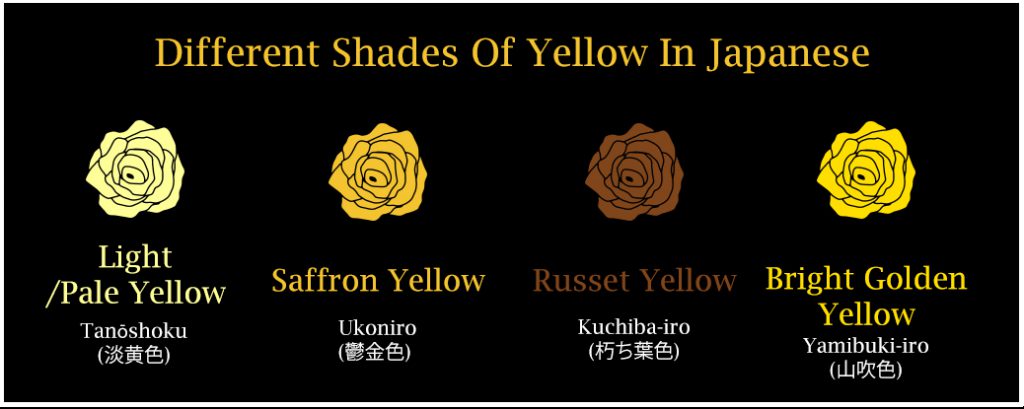
- Light/Pale Yellow – Tanōshoku (淡黄色)
- Saffron Yellow – Ukoniro (鬱金色)
- Russet Yellow – Kuchiba-iro (朽ち葉色)
- Bright Golden Yellow – Yamibuki-iro (山吹色)
Now, let’s get on to the topic at hand.
Meaning of Colors in Japanese
Red

In Japanese culture, the colour red represents authority and wealth. It is a powerful colour, and you can find proof in the Japanese flag, which consists of the colours red and white. And in the flag itself, you can see in the centre the red circle, which symbolises the sun. Even in marriage ceremonies, most brides wear traditional red attires. Moreover, red envelopes are used when money is offered as gifts on special occasions.
Purple

The colour purple symbolises royalty, nobility, and luxury.
There are only two countries in the world that use purple in their national flags: Dominica and Nicaragua. Other countries don’t include the colour in their flags because the purple dye is quite expensive. And as such, this colour was only affordable by the wealthy people in Japan in the past. In fact, ordinary people were not allowed to wear purple-coloured clothes then.
White

In the past, the Japanese’s colour of mourning was white. It was only after the western influence that they switched to black. In Japanese culture, and like many others, white represents purity and cleanliness. It is considered to be a blessed and sacred colour.
Blue

Japan, a nation surrounded by blue water, the colour blue symbolises purity, cleanliness, passivity and fidelity. It is considered a lucky colour and is a popular colour in Japanese clothing, such as kimonos. Indigo got its name ‘Japan Blue’ when foreigners visited Japan during the Meiji period. They were amazed to see Japanese towns covered with Indigo blue everywhere such as their beddings, towels, kimonos, etc.
Green

Green, another colour considered lucky in Japan, symbolises fertility, growth, youth, eternity, vitality and energy. The Japanese are nature-loving people, and on the 29th of April every year, which is the birthday of Emperor Shōwa, who loved nature, they celebrate Greenery Day.
Black

Black has been synonymous with death, evil, and destruction in almost every culture, so the colour of mourning is black in most countries, including Japan. Since ancient times to this day, black has been the colour used for makeup. Back then, the Japanese had a custom where they would paint their teeth black. This unusual custom called o-haguro, which involves dying one’s teeth black with dissolved iron and vinegar, prevents tooth decay. It is still practised during funerals by locals in the countryside and some geishas on special occasions.
Orange

For the Japanese, the colour orange represents happiness and love. It also indicates knowledge and civilization. It is among one of the most popular colours used in clothing.
Pink

Pink symbolises femininity, spring, youth, and good health, and it is among the popular colours in Japanese clothing in Japan. When it comes to character, this colour represents a child-like personality.
Yellow

In Japan, yellow symbolises nature and sunshine and is considered a sacred colour in the Far East. Yellow is used in many Japanese terms. For instance, when one has a ‘yellow beak’, it means that they are inexperienced and ‘yellow voice’ refers to the high-pitched voices of kids and women.
Brown

This wooden colour represents strength, endurance, comfort, simplicity, as well as Earth itself.
Gold

For the Japanese, gold represents wealth, royalty, prestige and the colour of the heavens. This colour is used to decorate temples and the statues of Lord Buddha.
Silver

Silver symbolises security, reliability, intelligence, staid, modesty, maturity and is commonly used in tools and weapons in Japan.
Japanese Traditional Color for Fashion
When it comes to fashion, we tend to follow the latest trends that we see on runways. There was a time when not following a fashion trend made one an outcast; no one dared don something so traditional. But, today, the rules of fashion have changed as people are now all about mix and match.
In Japan, many fashion houses are revamping their fashion styles with traditional outfits and colours. Let’s take the kimono, for instance. Kimono has become a fashion statement, and even international celebrities and luxury brands are flaunting them. Kourtney Kardashian was spotted wearing an Attico kimono mini dress back in 2017. People in Japan are now wearing kimonos to their workplace as well.
Japanese traditional colours have also become part of Japanese Fashion as many Japanese celebrities, especially J-pop stars such as the Japanese vocal duo YANAKIKU and Kyary Pamyu Pamyu, who have helped spread the kawaii and decora culture, were seen in outfits painted in the traditional colours of Japan.
Japanese Rubik’s Cube Colour Concept
Did you know that Rubik’s Cube has Japanese and Western colour alignments?
Although both follow the traditional Rubik’s Cube colours, white, yellow, orange, red, green, and blue, According to GoCube, “the Japanese Rubik’s cube has switched yellow and blue colours. In the case of Japanese cubes with a white plastic body, some have black stickers instead of white ones.” In this colour scheme, people prefer to start with a blue face.
The western colour scheme, also known as Minus Yellow, is called “BOY”: blue-orange-yellow. In this colour scheme, people usually start with the white face and finish with the yellow.
Symbolisms Of Anime Hair Colours
Did you know that the hair colours of anime characters hint at their personalities, predominantly female characters?
Take a look at this Anime Hair Colour’s Meanings:
Black Hair: Japanese generally have naturally black hair making it a standard hair colour. Anime characters with black hair are usually traditional, refined, mysterious and powerful, and some with dark past. Although black is mainly associated with evil, it is not so in the case of anime characters with black hair. Some even have positive character traits.
Blonde/Yellow Hair: A character with yellow hair or blonde hair is often the most crucial female lead or the “special someone”. The character traits vary for different anime characters with blonde or yellow hair. While some have good personalities, others are rude. It depends on the character and the plot.
Blue Hair: A character with blue hair is usually an introvert who is reserved, soft-spoken, and knowledgeable. The shade of blue hair colour is essential in the world of anime. For instance, characters with a lighter blue or sky blue hair colour are often portrayed as cute and approachable.
White Hair: White-haired anime characters are usually mysterious, wise, intelligent and strong-willed with unique abilities. They are also primarily introverts and reserved characters.
Red Hair: Redheads are typically passionate, headstrong, adventurous, aggressive and out-spoken. Whether their characters are good or bad, red-haired anime characters usually have strong emotions and often overreact. They typically possess leadership qualities.
Purple Hair: A character with purple hair will usually be noble, dainty and erudite. They can be strong, powerful and unpredictable at times. As purple represents royalty, these purple-haired characters are traditionally from noble backgrounds who are after wealth and worldly possessions.
Brown Hair: Anime characters with brown hair are usually ordinary and plain but warm, sincere, friendly, and approachable. In many anime, brown-haired characters are typically close friends or confidants of the protagonists.
Pink Hair: A character with pink hair tends to be cute, naive, and innocent. They usually have upbeat personalities and child-like innocence. They are generally female protagonists or the love interest of the male protagonist.
We hope the above information helps you understand more about the symbols of different colours in Japanese culture and how to say different colours in Japanese.
We will leave you here with our best wishes.
Until next time, Sayonara for now!

